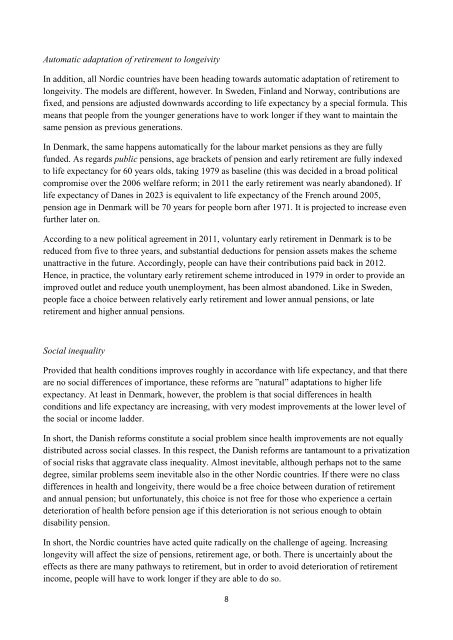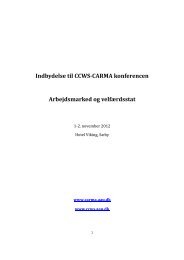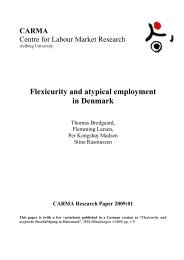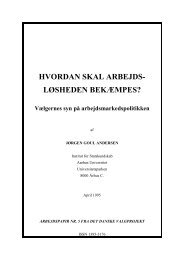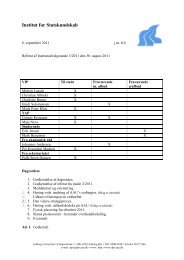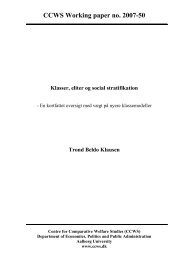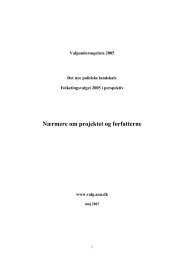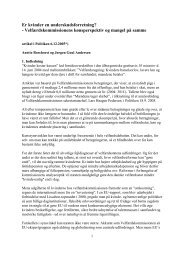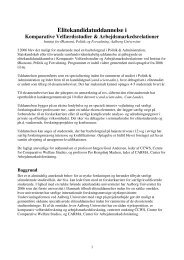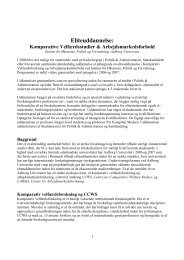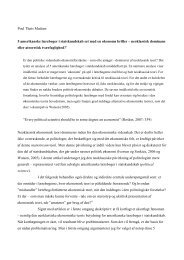Ageing and welfare reform in the Nordic Countries, 1990-2010 ...
Ageing and welfare reform in the Nordic Countries, 1990-2010 ...
Ageing and welfare reform in the Nordic Countries, 1990-2010 ...
Create successful ePaper yourself
Turn your PDF publications into a flip-book with our unique Google optimized e-Paper software.
Automatic adaptation of retirement to longeivityIn addition, all <strong>Nordic</strong> countries have been head<strong>in</strong>g towards automatic adaptation of retirement tolongeivity. The models are different, however. In Sweden, F<strong>in</strong>l<strong>and</strong> <strong>and</strong> Norway, contributions arefixed, <strong>and</strong> pensions are adjusted downwards accord<strong>in</strong>g to life expectancy by a special formula. Thismeans that people from <strong>the</strong> younger generations have to work longer if <strong>the</strong>y want to ma<strong>in</strong>ta<strong>in</strong> <strong>the</strong>same pension as previous generations.In Denmark, <strong>the</strong> same happens automatically for <strong>the</strong> labour market pensions as <strong>the</strong>y are fullyfunded. As regards public pensions, age brackets of pension <strong>and</strong> early retirement are fully <strong>in</strong>dexedto life expectancy for 60 years olds, tak<strong>in</strong>g 1979 as basel<strong>in</strong>e (this was decided <strong>in</strong> a broad politicalcompromise over <strong>the</strong> 2006 <strong>welfare</strong> <strong>reform</strong>; <strong>in</strong> 2011 <strong>the</strong> early retirement was nearly ab<strong>and</strong>oned). Iflife expectancy of Danes <strong>in</strong> 2023 is equivalent to life expectancy of <strong>the</strong> French around 2005,pension age <strong>in</strong> Denmark will be 70 years for people born after 1971. It is projected to <strong>in</strong>crease evenfur<strong>the</strong>r later on.Accord<strong>in</strong>g to a new political agreement <strong>in</strong> 2011, voluntary early retirement <strong>in</strong> Denmark is to bereduced from five to three years, <strong>and</strong> substantial deductions for pension assets makes <strong>the</strong> schemeunattractive <strong>in</strong> <strong>the</strong> future. Accord<strong>in</strong>gly, people can have <strong>the</strong>ir contributions paid back <strong>in</strong> 2012.Hence, <strong>in</strong> practice, <strong>the</strong> voluntary early retirement scheme <strong>in</strong>troduced <strong>in</strong> 1979 <strong>in</strong> order to provide animproved outlet <strong>and</strong> reduce youth unemployment, has been almost ab<strong>and</strong>oned. Like <strong>in</strong> Sweden,people face a choice between relatively early retirement <strong>and</strong> lower annual pensions, or lateretirement <strong>and</strong> higher annual pensions.Social <strong>in</strong>equalityProvided that health conditions improves roughly <strong>in</strong> accordance with life expectancy, <strong>and</strong> that <strong>the</strong>reare no social differences of importance, <strong>the</strong>se <strong>reform</strong>s are ”natural” adaptations to higher lifeexpectancy. At least <strong>in</strong> Denmark, however, <strong>the</strong> problem is that social differences <strong>in</strong> healthconditions <strong>and</strong> life expectancy are <strong>in</strong>creas<strong>in</strong>g, with very modest improvements at <strong>the</strong> lower level of<strong>the</strong> social or <strong>in</strong>come ladder.In short, <strong>the</strong> Danish <strong>reform</strong>s constitute a social problem s<strong>in</strong>ce health improvements are not equallydistributed across social classes. In this respect, <strong>the</strong> Danish <strong>reform</strong>s are tantamount to a privatizationof social risks that aggravate class <strong>in</strong>equality. Almost <strong>in</strong>evitable, although perhaps not to <strong>the</strong> samedegree, similar problems seem <strong>in</strong>evitable also <strong>in</strong> <strong>the</strong> o<strong>the</strong>r <strong>Nordic</strong> countries. If <strong>the</strong>re were no classdifferences <strong>in</strong> health <strong>and</strong> longeivity, <strong>the</strong>re would be a free choice between duration of retirement<strong>and</strong> annual pension; but unfortunately, this choice is not free for those who experience a certa<strong>in</strong>deterioration of health before pension age if this deterioration is not serious enough to obta<strong>in</strong>disability pension.In short, <strong>the</strong> <strong>Nordic</strong> countries have acted quite radically on <strong>the</strong> challenge of age<strong>in</strong>g. Increas<strong>in</strong>glongevity will affect <strong>the</strong> size of pensions, retirement age, or both. There is uncerta<strong>in</strong>ly about <strong>the</strong>effects as <strong>the</strong>re are many pathways to retirement, but <strong>in</strong> order to avoid deterioration of retirement<strong>in</strong>come, people will have to work longer if <strong>the</strong>y are able to do so.8


